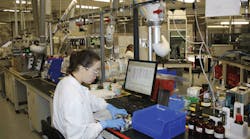At 8:15 a.m. on a Friday key members of Life Technology Inc.’s Austin, Texas, manufacturing operations convene in a conference room for a strategy session. The daily start-up meeting is a way to provide status updates on projects or initiatives and recognize employees for significant achievements. The session is a continuation of constant collaboration among the workforce in this laboratory environment.
"War rooms" throughout the complex provide self-sufficient work teams with analysis tools and dashboards they use to initiate their own improvements. These employee-led work groups, called "high-performance work teams," helped the plant gain new business and drive $4.2 million in productivity improvements in 2010.
Life Technologies’ Austin site produces ribonucleic acid (RNA) formulations used by researchers for applications in areas such as pharmaceutical testing, university labs and government research institutions. The high-mix/low-volume facility produces more than 670 unique products that involve preparing solutions and then dispensing bulk liquids into individual bottles, tubes or multiwell plates. The finished products are packaged and sold as kits or stand-alone products.
The plant has undergone a dramatic cultural transformation just three years after Applied Biosystems and Invitrogen merged to form Life Technologies. Brett Petrie joined the plant in 2007 after working for a pharmaceutical manufacturer to help convert the operation from an entrepreneurial environment to a lean plant. The facility had grown since its beginnings in 1989 as a six-employee startup called Ambion. But little manufacturing expertise existed in a company still heavily influenced by its science-based beginnings, says Petrie, senior director of manufacturing and global leader of operational excellence.
The first order of business was addressing foundational issues including an overhaul of data management systems and implementing financial accountability for managers, says Daniel Szura, the plant’s continuous-improvement manager. The facility advanced quickly with basic lean principles such as 5S. After gaining some quick wins, the facility moved forward with the creation of work cells, insourcing of certain raw materials and the formation of high-performance work teams.
Members of the work teams are cross-trained and track their available hours on a computerized scheduling dashboard. If the employee’s utilization rate is low, that worker can move to another line that needs assistance, says Caesar Almaraz, a leader for oligonucleotide production. Team-driven improvements played a deciding role in the facility being selected by the parent company as one of the anchor manufacturing sites for the company, plant leaders say. "Anytime you can layer high-performance work teams on top of lean and Six Sigma, then you've got a powerhouse that is very difficult to compete with," Petrie says.
Moving forward, the facility is on track to transfer another product line that will increase overall plant revenue 8% to 10% — another significant milestone since the lean transformation began. When Petrie arrived in 2007 time was running out on the plant’s ISO 9000 certification because of quality issues, he says.
Today, a countdown clock in the new product line’s war room keeps Life Technologies’ Austin employees focused on moving the plant beyond survival to a thriving manufacturing center.



